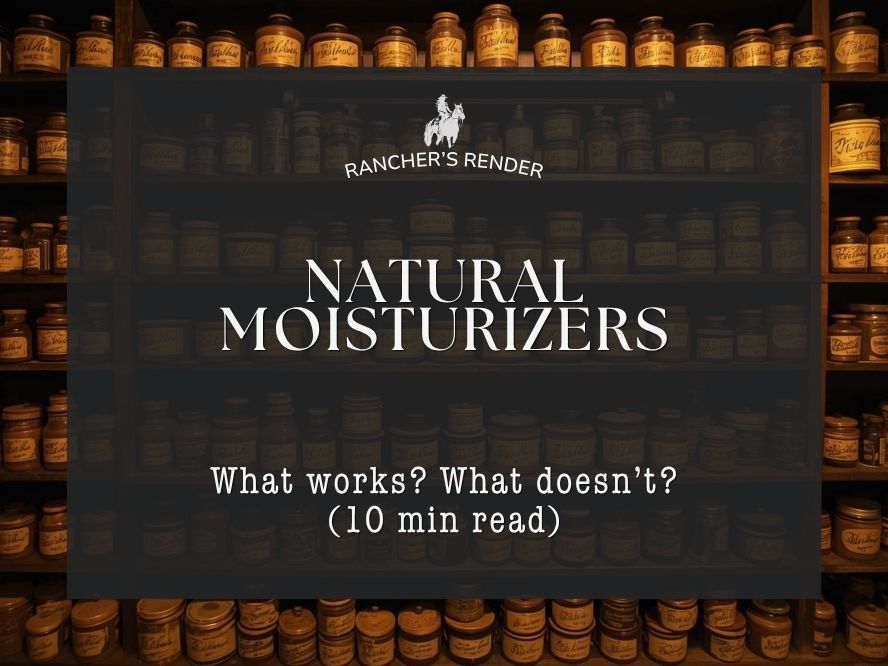
Natural Face Moisturizer: Simple Ingredients That Actually Work
What Makes a Moisturizer "Natural"?
Let's start with the uncomfortable truth: there's no official definition of "natural" in skincare.
The FDA doesn't define it. The FTC doesn't regulate it. When a product claims to be a "natural moisturizer" or "all natural moisturizer for face," that could mean anything—or nothing.
Here's what these terms actually mean:
- "Natural" = whatever the brand wants it to mean
- "Organic" = must meet USDA standards (if agricultural ingredients)
- "Clean" = another meaningless marketing term
- "Non-toxic" = everything is toxic at some dose, even water
Why do people seek natural face moisturizers anyway? Survey data shows 57% of U.S. women prefer all-natural products, but 73% can't actually define what "natural" means. The motivation usually comes from:
- Sensitive skin reactions to synthetic preservatives
- Pregnancy or breastfeeding safety concerns
- Environmental consciousness
- Belief that natural equals safer (spoiler: it doesn't always)
The reality? Natural ingredients can be incredibly effective—or completely useless. It depends entirely on the ingredient, how it's processed, and whether it's properly preserved.
How Natural Moisturizers Work (And When They Don't)
Before evaluating any natural skin moisturizer, you need to understand how moisturizers actually function. There are three mechanisms:
Humectants draw water to your skin. Think glycerin, hyaluronic acid, honey, and aloe vera. They pull moisture from deeper skin layers and from humid air. But here's the catch—in dry climates below 30% humidity, humectants can actually pull water OUT of your skin, making dryness worse.
Emollients fill the gaps between skin cells, smoothing texture and delivering beneficial lipids. These include plant oils, butters, and—yes—tallow. They rebuild your skin's natural barrier by mimicking its lipid composition.
Occlusives create a physical seal to lock in moisture. Beeswax, shea butter at high concentrations, and even petroleum jelly (though not natural) work as occlusives. They don't add moisture—they prevent what's already there from escaping.
The best natural moisturizer for dry skin combines all three. Humectants alone won't cut it. Occlusives without humectants just sit on top. And emollients by themselves might not provide enough hydration for very dry skin.
Here's what most "natural" brands won't tell you: without proper preservation, any moisturizer containing water becomes a bacteria breeding ground within days. That's not natural—that's dangerous.
Breaking Down Popular Natural Moisturizer Ingredients
Let's examine each ingredient honestly—what works, what doesn't, and what to watch for.
Grass-Fed Tallow (The Ancestral Powerhouse)
Tallow's fatty acid profile is remarkably similar to human sebum—that's your skin's natural moisturizer. Both contain about 50-55% saturated fats with nearly identical ratios of oleic, palmitic, and stearic acids.
The science: Grassfed tallow contains 43-47% oleic acid and 26% palmitic acid, creating a composition that penetrates easily because your skin recognizes it. It's also rich in fat-soluble vitamins A, D, E, and K that synthetic moisturizers struggle to replicate.
Quality matters enormously: Tallow from kidney fat (suet) is white, odorless, and ideal for skincare. Tallow from trim fat? That's where the "beefy" smell comes from. The difference is like comparing extra virgin olive oil to the stuff scraped from a deep fryer.
Stability: When properly rendered with all water removed and tested for water activity below 0.75, tallow is incredibly shelf-stable without synthetic preservatives.
The honest take: Tallow scores 2-3 on the comedogenic scale, meaning some people might experience clogged pores. It's not magic. It's not "better than Botox." It's simply an excellent moisturizer for most skin types when properly sourced and processed.
Aloe Vera (The Cooling Soother)
Aloe vera moisturizer sounds perfect—natural, soothing, straight from the plant. The reality is more complicated.
Benefits: Clinical studies show aloe extracts at just 0.10% concentration significantly improve skin hydration. The polysaccharides bind moisture while compounds like acemannan stimulate collagen production.
The problem: Fresh aloe is 99% water. Without preservatives, it becomes contaminated within days. Worse, improperly processed aloe containing latex (the yellow substance under the leaf skin) contains anthraquinones that are classified as possible carcinogens.
Bottom line: Great for temporary relief of sunburn or irritation. Risky for daily use unless properly preserved and processed to remove harmful compounds.
Coconut Oil (The Controversial Favorite)
Despite its popularity as a natural moisturizer for face, coconut oil is problematic for leave-on facial use.
The science: Coconut oil rates 4 out of 5 on the comedogenic scale—that's "fairly likely to clog pores" when left on facial skin. Its high lauric acid content (48%) makes it antimicrobial but also highly comedogenic for many people.
The melting point issue: Coconut oil melts at 76°F. It's solid on your shelf, liquid in your pocket, solid again in air conditioning. This instability affects both texture and application for leave-on products.
Where coconut oil actually works:
- In soap (like our tallow soap) - the saponification process changes the oil chemically, and soap is rinse-off product, not sitting on your skin for extended periods of time
- Body moisturizing on non-acne-prone skin
- Hair treatments - excellent for dry ends
- Oil cleansing - when it's being washed off
The bottom line: Coconut oil has its place in natural skincare—just not as a leave-on facial moisturizer for most people. There's a big difference between using it in a rinse-off product like soap (where it provides excellent lather and cleansing) versus slathering it on your face overnight.
Shea Butter (The Heavy Hitter)
Shea butter brings unique chemistry to natural face cream for dry skin.
The good: Despite its richness, shea butter scores 0 on the comedogenic scale—completely non-pore-clogging. Its high unsaponifiable content (8-17%) provides anti-inflammatory compounds that most plant oils lack.
The texture reality: Pure shea is often too heavy for facial use, especially on oily skin. It works better blended with lighter oils or whipped for easier spreading.
Processing matters: Unrefined shea butter preserves vitamins A, E, and F. Refined shea might be white and odorless, but it loses up to 95% of beneficial vitamins through processing.
Jojoba Oil (The Lightweight Option)
Technically not an oil but a liquid wax ester, jojoba brings exceptional stability to natural facial moisturizer formulations.
Unique structure: Composed of 97% wax esters rather than triglycerides, jojoba resists oxidation far better than true oils. It mimics compounds in human sebum, making it highly compatible with skin.
Balanced performance: With a comedogenic rating of 2, jojoba works for most skin types including mildly acne-prone. It provides moisture without heaviness.
The limitation: Lacks occlusive properties for very dry skin. Better as part of a formula than a standalone moisturizer for dry skin.
Honey (The Sticky Situation)
Honey functions as a powerful humectant, but practical application gets messy—literally.
The science: Honey's water activity of 0.56-0.62 prevents bacterial growth. Clinical studies show formulas with 15% honey reduced wrinkles by 21% after four weeks.
The reality: Sticky residue attracts dirt and debris. Raw honey can contain bacterial spores. Better as a wash-off mask than leave-on moisturizer.
Medical-grade only: If using honey in skincare, medical-grade Manuka honey with standardized antimicrobial activity beats random grocery store varieties.
Essential Oils (The Scent Trap)
Here's what nobody mentions: essential oils are the #1 cause of "natural" skincare reactions.
The data: Studies show 8.3% of people react to at least one essential oil, with ylang ylang (3.9%) and lemongrass (2.6%) topping the sensitivity list. Reactions often appear 12-72 hours after application—not immediately.
Oxidation makes it worse: Essential oils become MORE allergenic as they age. That lavender oil from two years ago? It's probably full of sensitizing compounds now.
Safe use: Maximum 1-3% dilution for facial products. But honestly? Your facial skin doesn't need fragrance, natural or synthetic.
Choosing the Right Natural Moisturizer for Your Skin Type
Not all natural moisturizers work for every skin type. Here's how to choose:
For Dry Skin
You need heavy occlusives plus emollients. The best natural moisturizer for dry skin combines:
- Tallow or shea butter for occlusion and barrier repair
- Humectants like honey or glycerin for water attraction
- Rich oils for emollient action
Skip anything with high water content unless properly preserved. Apply to damp skin for better absorption. Consider using a natural face moisturizer for dry skin during the day and a heavier balm at night.
For Sensitive Skin
Priority: minimal ingredients, zero fragrances.
- Unscented tallow with its biocompatible fatty acids
- Pure squalane (derived from olives or sugarcane)
- Single-ingredient products to identify triggers
Patch test everything for 48 hours. Even natural face moisturizer for sensitive skin can cause reactions. What works for others might not work for you.
For Oily/Combination Skin
You still need moisture—oil production often increases when skin is dehydrated. Look for:
- Lightweight oils like jojoba or grapeseed
- Gel-based formulas with aloe (properly preserved)
- Small amounts of whipped tallow for targeted dry areas
The myth that oily skin shouldn't use oil-based products is exactly that—a myth. The right oils can actually help regulate sebum production.
For Mature Skin
Focus on barrier repair and nutrient delivery:
- Tallow's fat-soluble vitamins support skin regeneration
- Rose hip oil for vitamin C and retinol alternatives
- Whipped textures for easier spreading on delicate skin
DIY Natural Moisturizers vs. Professional Standards
Let's address the elephant in the room: those Pinterest DIY recipes for homemade natural moisturizer.
The Appeal of DIY
We get it. Making your own products feels empowering. You control the ingredients. It seems cheaper. And honestly? It's fun kitchen chemistry.
We started there too—rendering tallow on the kitchen stove, mixing in whatever essential oils smelled nice.
The Hidden Risks
Here's what those DIY blogs don't mention:
- Contamination happens fast—within 3-5 days for water-containing products
- No way to test water activity, pH, or microbial load at home
- Inconsistent results batch to batch
- Unknown shelf life without stability testing
That "all-natural preservative" (usually vitamin E or rosemary extract)? It prevents oil rancidity, not bacterial growth. Two completely different things.
Professional Standards That Matter
Real natural skincare requires:
- Water activity testing keeping levels below 0.75 for safety
- Consistent sourcing (same cattle, same feed, same processing)
- Temperature-controlled processing preserving beneficial compounds
- Batch testing for contamination and stability
This isn't about scaring you away from DIY. Single-use masks? Go for it. Daily facial moisturizer? Invest in tested products.
Learn More About Water Activity
Discover why water activity testing matters more than preservatives →
Quality Standards Most Brands Won't Discuss
If you're evaluating any natural moisturizer for dry skin or sensitive skin, ask these questions:
Source Material Transparency
Can the brand tell you exactly where ingredients come from? Not "local farms" or "grass-fed cattle" but specific locations?
For tallow: Is it from suet (kidney fat) or trim fat? Makes a 10x quality difference.
For plant oils: Single source or blended from multiple suppliers?
For botanical extracts: Standardized potency or variable batches?
Processing Differentiators
How ingredients are processed matters as much as the ingredients themselves:
- Wet vs. dry rendering for tallow (affects odor and purity)
- Cold-pressed vs. heat-extracted oils (preserves nutrients)
- Extraction method for botanicals (CO2, alcohol, water)
Temperature control during processing can preserve or destroy beneficial compounds. Under 140°F maintains vitamins. Over 275°F creates breakdown products.
Testing and Documentation
Legitimate brands test:
- Water activity for preservation adequacy
- Microbial contamination throughout shelf life
- Oxidation markers for oil rancidity
- Heavy metals in botanical ingredients
No testing = no idea what you're putting on your face.
Why Some Tallow Smells
Why Your Tallow Balm Smells Beefy (Pure Suet vs Trim Fat) →
Frequently Asked Questions
"What can I use to moisturize my face naturally at home?"
For immediate relief: pure aloe from the plant (single use only) or a drop of olive oil on damp skin. For daily use? Invest in one properly formulated product rather than experimenting with ten DIY disasters.
"How can I cure dry skin on my face overnight with home remedies?"
First, "cure" is the wrong word—you manage dry skin, not cure it. For overnight treatment, cleanse gently, apply a humectant to damp skin, then seal with an occlusive like pure tallow balm. Skip the home remedies involving food from your fridge.
"How to moisturize face naturally without products?"
Your skin produces its own moisturizer (sebum), but if that's not enough, you need external help. Drinking water helps overall health but won't fix dry facial skin. The idea that you can moisturize without moisturizer is like trying to clean without soap—technically possible but not very effective.
"Is tallow comedogenic?"
Tallow rates 2-3 on the comedogenic scale—moderate likelihood of clogging pores for some people. Individual reactions vary based on skin type, application amount, and tallow quality. Start with small amounts and patch test.
"Will tallow make me smell like beef?"
Only if it's made from trim fat or poorly rendered. Quality tallow from suet, properly processed, has virtually no scent. If your tallow balm smells beefy, find a better source.
"How long does natural moisturizer last?"
Depends entirely on formulation and preservation:
- DIY without preservatives: 3-7 days
- Natural with weak preservation: 3-6 months
- Properly formulated: 12-18 months
- Anhydrous (no water): 6-12 months with antioxidants
Making an Informed Decision (Our Perspective)
After two decades raising cattle and several years formulating skincare, here's our take on natural face moisturizers:
The three questions that matter:
- Where does it come from? (Transparency beats vague claims)
- How is it processed? (Methods matter as much as ingredients)
- What proves it's safe? (Testing or just hoping?)
We chose tallow not because it's trendy (we were rendering before TikTok existed) but because the science makes sense. Its fatty acid profile matches human sebum. It's stable without synthetic preservatives when properly processed. And we control every step from pasture to jar.
But tallow isn't magic. It won't reverse aging, cure acne, or replace Botox. It's simply an excellent moisturizer when you need one that works with your skin instead of against it.
Our promise: No miracle claims. No fear-mongering about "toxic" competitors. Just honest information about what works, what doesn't, and why quality matters more than "natural" labels.
If you're tired of natural moisturizers that smell weird, feel greasy, or go rancid in a month, maybe it's time to try tallow that's actually done right.
Ready to Try Quality Tallow?
Unscented Whipped Tallow Cream - For daily moisture without the BS →
Need Serious Overnight Repair?
Pure Tallow Balm - When your skin needs actual help, not hope →
The best natural face moisturizer isn't the one with the prettiest label or the most exotic ingredients. It's the one that's properly formulated, honestly marketed, and actually tested for safety. Everything else is just expensive hope in a jar.
Share

